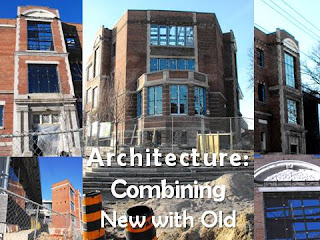Architecture: Combining New and Old
 Photo-collage: Architecture: Combining New with Old
Photo-collage: Architecture: Combining New with OldAcknowledge the history of the place +
Impose new ideas for evolution and growth
2011 @ wobuilt.com
Cities grow, evolve and combining the new with the old in the same area will acknowledge the history of the place. Projects that pay homage to the existing fabric of a space, but also incorporate new architecture would be my ideal.
I have asked myself recently which commercial/non-residential projects I ideally would like to secure for Wo-Built. Projects that pay homage to the existing, but also incorporate new architecture would be my ideal. The choice has a lot to do with my attitude to city planning and architecture which started to be formed during my visits to Berlin in the late 1980's.
I fully embraced the West Berlin’s attitude to architecture. To build something new at that time meant that the old had to be torn down. This thinking gave way to some amazing projects by international architects, Zaha Hadid, Giorgio Grassi, Rob Krie, Peter Eisenmann, Peter Cook + Christine Hawley with Hinrich & Inken Baller, Aldo Rossi. West Berlin was a show piece and it was certainly showing off. Walking around was very exciting. Ever so often an interesting piece of architecture occupied a space in between the older buildings. Not trying to fit in, just standing on its own merits. Even today I like the idea to see new and architecturally exciting modern non matching infill buildings in the fabric of a city.
When I returned to the unified Berlin in the early 2000's and I was both amazed and bit disappointed at the transformation of the previous East Berlin. In the 1980's only a handful of buildings had been restored most likely due to cost and a lot of emphasis had been made on building monumental socialist's housing projects after the war. After reunification this area saw an enormous amount of new and modern buildings in some areas, but many historical buildings and whole streets were rebuilt (of course modernized) the same way as they were before the Second World War.
Berlin was an architecturally splendid city before the war and one can understand the desire to rebuild it as it was. But this was an opportunity missed. Thinking about it philosophically, combining new and old allows opportunity to acknowledge the fabric of the city as it was and to impose new ideas for evolution and growth. I felt at the time that effectively 45 years of memory were eradicated. Cities grow, evolve and combining the new with the old in the same area will acknowledge the history of the place.
We have great examples of this in Toronto. The Michael Lee Chin Crystal (Renaissance ROM, the Royal Ontario Museum's renovation and expansion project) by Daniel Libeskind, and Frank Geary’s extension to the Art Gallery of Ontario (Transformation AGO: New Building) to name a few of civic scale. On a smaller scale a new site of the police station at 2054 Davenport Road which also uses an existing building as part of the new design. We also have some bold infill buildings like the co-operative residential building at 60 Richmond Street East, but we need more building initiatives that either combine the old fabric with the new or boldly insert themselves into the existing fabric of the city at the same scale.
We would love to take part in the evolution of Toronto cityscape combining old with new.
Martina Ernst
Wo-Built Inc. - Innovative Design and Build
links:
e-architect.co.uk: Berlin IBA Architecture, Germany : Information
Internationales Bau Ausstellung : Architecture in German Capital
nationalpost.com: Pug Awards: Housing Co-op and Royal Conservatory come out on top
by Kristen Smith Jun 17, 2010
rom.on.ca: Michael Lee-Chin Crystal
ago.net: The New AGO: Frank Gehry's Redesign
torontopolice.on.ca: 11 Division - new site
The architect selected for this project is Stantec Architecture Limited, Architects.
The construction management service chosen is Eastern Construction Company Limited.


















